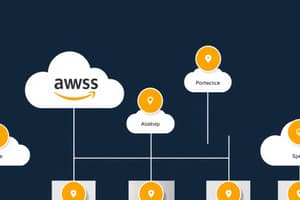Podcast
Questions and Answers
What is a defining characteristic of an internal cloud?
What is a defining characteristic of an internal cloud?
- It requires paying third parties based on usage.
- It uses resources from public cloud providers.
- It involves creating resources on your own internal network. (correct)
- It eliminates the need to build a data center.
How does the cost structure of an external cloud typically work?
How does the cost structure of an external cloud typically work?
- You pay a fixed amount regardless of usage.
- There are no costs associated with external clouds.
- Costs vary based on usage and consumption. (correct)
- Upfront costs are never applicable.
Which term describes the service payment structure where users only pay for resources as they consume them?
Which term describes the service payment structure where users only pay for resources as they consume them?
- Subscription services
- Metered cloud services (correct)
- Flat-rate services
- Prepaid services
What is typically required for establishing an internal cloud?
What is typically required for establishing an internal cloud?
What advantage does an internal cloud have in terms of cost?
What advantage does an internal cloud have in terms of cost?
Which of the following best describes a non-metered cloud service?
Which of the following best describes a non-metered cloud service?
Which of the following statements about external cloud services is NOT true?
Which of the following statements about external cloud services is NOT true?
What does building an internal cloud typically necessitate?
What does building an internal cloud typically necessitate?
What does 'rapid elasticity' in cloud applications refer to?
What does 'rapid elasticity' in cloud applications refer to?
Why is high availability important in a cloud environment?
Why is high availability important in a cloud environment?
How do cloud providers ensure data synchronization across different geographical locations?
How do cloud providers ensure data synchronization across different geographical locations?
What is Desktop as a Service (DaaS)?
What is Desktop as a Service (DaaS)?
What technology does DaaS rely on for connecting users to their virtual desktops?
What technology does DaaS rely on for connecting users to their virtual desktops?
What is a potential challenge associated with using Desktop as a Service?
What is a potential challenge associated with using Desktop as a Service?
Which of the following best describes a Virtual Desktop Infrastructure (VDI)?
Which of the following best describes a Virtual Desktop Infrastructure (VDI)?
What is a key advantage of having redundancy in a cloud-based platform?
What is a key advantage of having redundancy in a cloud-based platform?
When deploying application instances in the cloud, what must be ensured for data consistency?
When deploying application instances in the cloud, what must be ensured for data consistency?
What type of service does Amazon Workspaces offer?
What type of service does Amazon Workspaces offer?
Flashcards
Internal Cloud
Internal Cloud
A cloud deployment model where resources are managed and provisioned within an organization's own data center or network.
External Cloud
External Cloud
A cloud deployment model where resources are provided and managed by a third-party cloud provider, such as Amazon Web Services (AWS), Microsoft Azure, or Google Cloud Platform (GCP).
Metered Cloud Services
Metered Cloud Services
A pricing model for cloud services where users pay only for the resources they consume. This includes features like storage, processing power, and bandwidth.
Non-Metered Cloud Services
Non-Metered Cloud Services
Signup and view all the flashcards
Building Your Own Cloud
Building Your Own Cloud
Signup and view all the flashcards
Public Cloud
Public Cloud
Signup and view all the flashcards
Private Cloud
Private Cloud
Signup and view all the flashcards
Hybrid Cloud
Hybrid Cloud
Signup and view all the flashcards
Rapid Elasticity
Rapid Elasticity
Signup and view all the flashcards
Desktop as a Service (DaaS)
Desktop as a Service (DaaS)
Signup and view all the flashcards
Virtual Desktop Infrastructure (VDI)
Virtual Desktop Infrastructure (VDI)
Signup and view all the flashcards
High Availability
High Availability
Signup and view all the flashcards
File Synchronization
File Synchronization
Signup and view all the flashcards
Amazon Workspaces (DaaS)
Amazon Workspaces (DaaS)
Signup and view all the flashcards
Remote Desktop
Remote Desktop
Signup and view all the flashcards
Minimal Data Transmission
Minimal Data Transmission
Signup and view all the flashcards
Network Connection
Network Connection
Signup and view all the flashcards
Study Notes
Cloud Deployment Methods
-
Internal Cloud: Resources are created on your own network. Requires building and maintaining a data center. No extra usage fees, as you own the infrastructure.
-
External Cloud: Uses a third-party provider (e.g., Amazon, Microsoft). Resources are shared on a large public cloud, often in multiple data centers globally. Cost varies, sometimes upfront, or pay-as-you-go (metered).
Cloud Pricing Models
-
Metered Cloud Services: Cost is based on use (e.g., file uploads/downloads, storage). Low entry cost, pay only for what you use.
-
Fixed Cost Cloud Services: A flat fee for a specific service (e.g., file transfers). Allows for unlimited use within the set price bracket for the month.
Cloud Instance Management
-
Rapid Elasticity: Easily scale up or down instances based on load fluctuations. Changes are transparent to the end-user.
-
High Availability: Redundancy built into the cloud platform to maintain operation even during outages (e.g., multiple network lines, backup generators). Varying levels of redundancy among providers.
-
Data Synchronization: Ensures data consistency across different data centers worldwide. Cloud providers offer various synchronization methods.
Cloud-Based Desktops
-
Desktop as a Service (DaaS): Running a Windows desktop entirely in the cloud. Accessed from any device via a network connection (tablet, phone, etc.).
-
Virtual Desktop Infrastructure (VDI): A cloud-based service where applications run within the service allowing for desktop access on a user device.
-
Screen Sharing/Remote Desktop: A remote desktop view of a Windows environment, accessed from a tablet, phone or computer. Network connection crucial and the technology sends a modest amount of data between the client and the desktop.
-
Example Service: Amazon Workspaces is an example of DaaS.
Studying That Suits You
Use AI to generate personalized quizzes and flashcards to suit your learning preferences.




